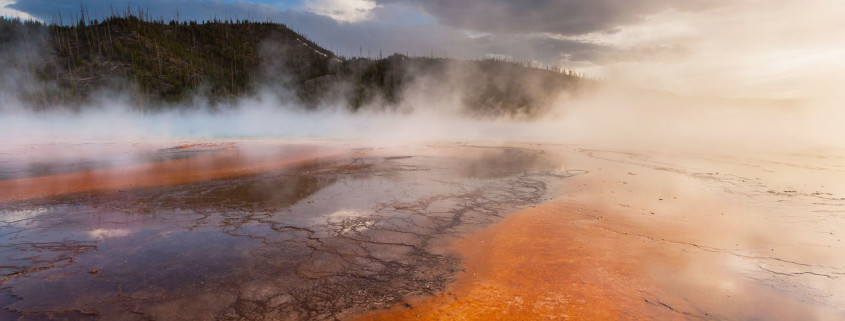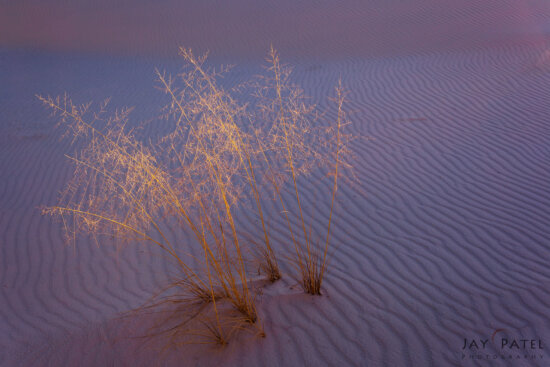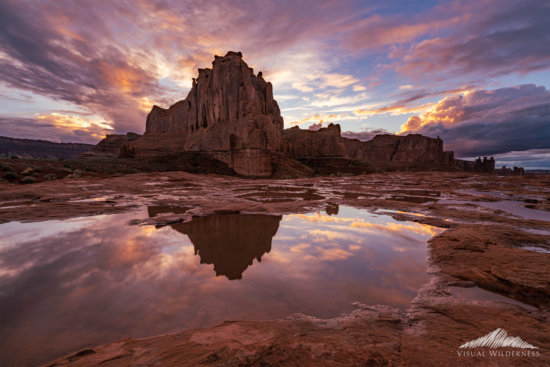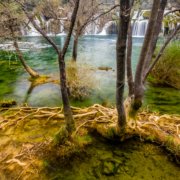8 Wide-Angle Composition Tips for Landscape Photography
When it comes to landscape photography, few tools offer as much creative potential as a wide-angle lens. The ability to capture grand vistas, dramatic skies, and immersive foregrounds makes it a favorite among nature photographers. However, mastering composition with a wide-angle lens requires more than just fitting “more” into the frame.
To truly tell a visual story through your landscapes, you need to make intentional compositional choices that guide your viewer’s eye and evoke emotion.
Below are essential wide-angle landscape photography composition tips that will help you craft images that feel alive and full of depth — from experimenting with tripod height to using perspective and light to create a narrative.
Why Composition Matters in Wide-Angle Landscape Photography
A wide-angle lens (typically 14mm to 35mm on a full-frame camera) exaggerates perspective and enhances the sense of depth in your image. But this power can be tricky. Without thoughtful composition, your photos can feel cluttered or flat — instead of dynamic and immersive.
Strong composition bridges that gap. It transforms a technically perfect shot into one that tells a story, guiding your viewer’s eye and drawing them emotionally into your scene.
1. Experiment with Tripod Height
Changing your tripod height is one of the simplest and most effective ways to improve wide-angle landscape composition. Because wide lenses exaggerate perspective, even a small shift in height can dramatically alter how elements relate to each other.
- Go low for drama and depth:
Lower your tripod close to the ground to emphasize foreground interest — such as textured rocks, blooming flowers, or flowing water. This perspective makes your viewer feel like they’re stepping into the scene. - Raise your tripod for balance:
Shooting higher allows you to include more of the midground and background. This is especially effective when capturing rolling hills or layered mountain ranges.
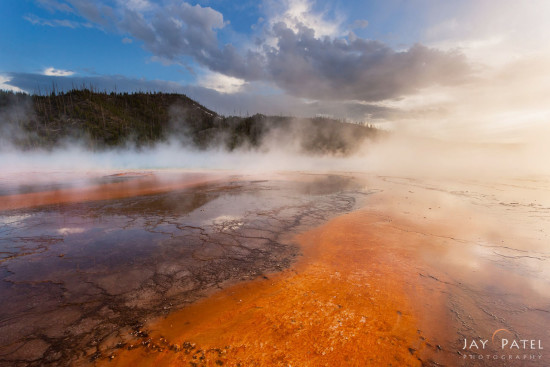
Mid tripod height selected to capture the dramatic foreground of Lower Geyser Basin, Yellowstone National Park, Wyoming by Jay Patel
✅ Pro Tip: Shoot the same scene from several heights. A difference of just a few inches can transform your composition from static to cinematic.
2. Manage Distracting Elements
Wide-angle lenses capture everything — including what you didn’t intend. That’s why one of the biggest challenges in wide-angle landscape photography is deciding what belongs in the frame and what doesn’t.
- Simplify your scene:
Look through your viewfinder and ask: Does this element contribute to my story? If not, recompose or move your position. - Watch the edges:
Stray branches, bright rocks, or uneven patches of sky can pull attention away from your subject. Always check your corners before pressing the shutter. - Balance chaos with structure:
Nature is full of visual noise. Use leading lines, natural frames, and foreground anchors to bring order and flow.
By consciously excluding distractions, you focus your viewer’s attention on the emotional core of your story.
3. Create a Visual Path with a Wide-Angle Lens
A successful landscape photograph doesn’t just show a place — it leads the viewer through it. One of the greatest strengths of a wide-angle lens is its ability to create a visual path that draws the eye from foreground to background.
- Use leading lines:
Roads, rivers, fences, trails, or even cloud patterns can naturally guide the viewer’s gaze. Align these lines so they move from the bottom of your frame toward your subject or horizon.
- Anchor with a strong foreground:
Get close to a visually interesting element — a rock, flower, or pool of water — to give your viewer an entry point into the landscape. - Layer your composition:
Think in terms of foreground, midground, and background. The viewer’s eye should journey through each, revealing details along the way.
A deliberate visual path transforms your photo from a static snapshot into a visual story that unfolds as the viewer explores it.
4. Use Perspective to Emphasize Foreground Elements
Perspective is one of the most powerful storytelling tools in wide-angle photography. By exaggerating distances and scale, it allows you to highlight key subjects and create depth.
- Get close — really close:
Move within inches of your foreground subject to make it appear larger and more dominant in the frame, while the background recedes. This adds dramatic perspective and dimension.

Getting close to lupines with a wide angle lens to fill the frame with them: Landscape Photography from Hof, Iceland by Jay Patel
- Tilt with care:
Slightly tilt your camera down to capture more foreground, but avoid extreme angles that distort vertical lines unnaturally. - Contrast shapes and textures:
Pair smooth skies with rugged rocks, or calm reflections with jagged mountains. Contrast creates visual tension — and storytelling interest.
The magic of a wide-angle lens lies in how it transforms scale and distance into emotional impact.
5. Pay Attention to the Horizon Line
The horizon line is your visual anchor. Where you place it affects how your viewer experiences the scene.
- High horizon = foreground focus:
When your story lies in the ground textures — sand ripples, wildflowers, or ice patterns — keep the horizon high to emphasize what’s underfoot. - Low horizon = dramatic skies:
When the light, clouds, or stars take center stage, lower your horizon to let the sky dominate. - Keep it level:
A crooked horizon instantly breaks immersion. Use your camera’s virtual level or correct it in post-processing.
The horizon is like punctuation in your composition — it tells your audience where to pause and breathe.
6. Use Light to Shape Your Story
Light is the emotional language of photography. The way it interacts with your composition defines the mood of your story.
- Golden hour warmth:
Early morning and late afternoon light adds warmth, direction, and soft shadows that reveal texture and dimension. - Side lighting for depth:
When light comes from the side, it sculpts shapes and emphasizes three-dimensionality — perfect for wide-angle compositions. - Backlighting for atmosphere:
Shooting toward the sun creates glow, silhouettes, and ethereal edges that add mystery and drama.
In landscape storytelling, light is your narrator. Use it to reveal emotion, not just exposure.
7. Compose with Intention: Build a Story, Not Just a Scene
Every strong landscape image has a central idea — a feeling, a moment, or a connection to place. Before you press the shutter, pause and ask:
- What story am I telling?
- What is my main subject?
- How do the elements in my frame support it?

Wide angle lens used to capture the story of a lone flower holding on in Yellowstone National Park, Wyoming
The foreground sets the stage, the midground provides context, and the background creates atmosphere. When these layers work together, your photo becomes more than just a beautiful scene — it becomes a visual narrative.
8. Fine-Tune Your Composition in Post-Processing
Even with careful in-camera composition, subtle refinements can enhance your story.
Use cropping to improve balance, remove minor distractions, or strengthen your visual flow. Tools like dodging and burning or radial filters can help guide the viewer’s eye toward your focal point — much like a director spotlighting key moments in a film.
Editing should never replace good composition, but it can refine your storytelling voice.
Conclusion: Let Your Wide-Angle Lens Be Your Storyteller
A wide-angle lens is not just a way to capture “everything” — it’s a tool for expressing how you see the world. When you combine thoughtful composition techniques with creative use of perspective and light, you create images that are not only visually powerful but emotionally resonant.
So next time you’re standing before a breathtaking landscape, take a moment. Move your tripod. Eliminate distractions. Search for leading lines, glowing light, and textures that tell your story.
Let your wide-angle lens be your visual storyteller, translating your awe and wonder into photographs that make others feel it too.
Because in the end, landscape photography is not just about what you see — it’s about how deeply you connect with what’s before you.

